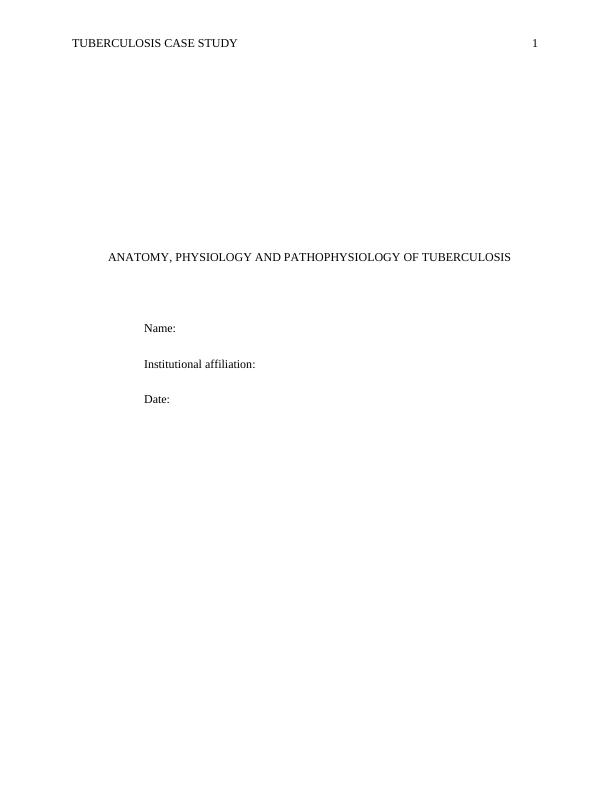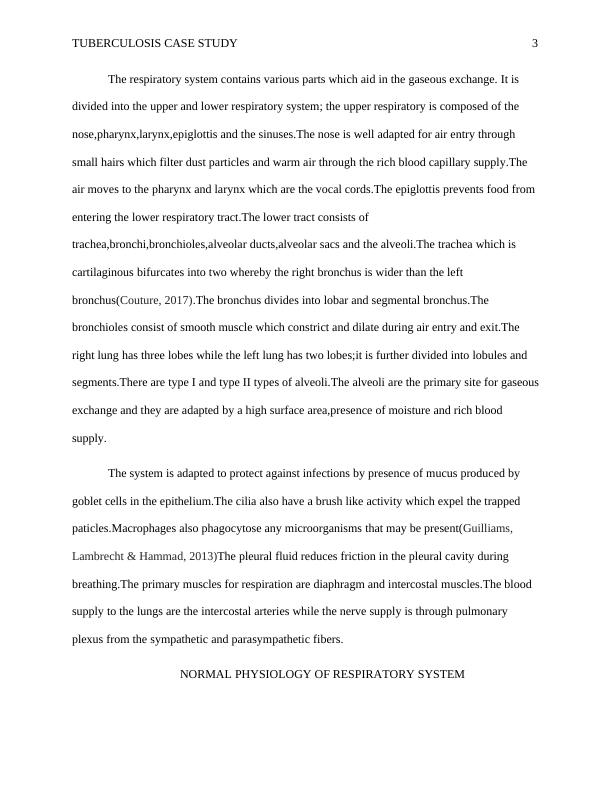Anatomy, Physiology and Pathophysiology of Tuberculosis
Added on 2023-04-04
10 Pages1922 Words273 Views
TUBERCULOSIS CASE STUDY 1
ANATOMY, PHYSIOLOGY AND PATHOPHYSIOLOGY OF TUBERCULOSIS
Name:
Institutional affiliation:
Date:
ANATOMY, PHYSIOLOGY AND PATHOPHYSIOLOGY OF TUBERCULOSIS
Name:
Institutional affiliation:
Date:

TUBERCULOSIS CASE STUDY 2
INTRODUCTION
Tuberculosis is a primarily respiratory infection which is caused by mycobacterium
tuberculosis. This may however spread to extrapulmonary sites such as the bones and the brain.
It affects the various body systems particularly the respiratory system. It is spread through air
droplets when one coughs, sneezes and prolonged contact with infected person. There are two
phases latent where one has the microorganism but noninfectious as the immune system has
controlled it. The infectious patient with tuberculosis when the immune system is unable to
control the organism. The macrophage phagocytoses the bacilli in a granuloma. When the
immune system weakens the granuloma now known as the Goon tubercle releases the bacilli and
the person is now infectious. Due to mutation of the microorganism or nonadherence to
medication there have been reported cases of multi drug resistant tuberculosis and extensively
drug resistant tuberculosis.
According to the World Health Organization (2018) tuberculosis is one of the leading
infectious causes of death in the world. In 2017,1.6 million of 10 million people infected with
tuberculosis succumbed. Tuberculosis has been associated with immune suppression such as
HIV/AIDs and people taking immunosuppressants due to different conditions. In the United
States there were 9105 new cases of tuberculosis in 2017(Center for Disease Control,2018). This
was reported in all the states across the country. The mortality rate however was also increased
from the year 2016.The diagnosis of tuberculosis is done through the Mantoux test also known as
tuberculin test.The definitive diagnosis is through chest xray,positive culture test by sputum and
molecular tests.Bacille Calmette Guertin is a vaccine given to provide immunity against
tuberculosis depending on different country policies.
NORMAL ANATOMY OF RESPIRATORY SYSTEM
INTRODUCTION
Tuberculosis is a primarily respiratory infection which is caused by mycobacterium
tuberculosis. This may however spread to extrapulmonary sites such as the bones and the brain.
It affects the various body systems particularly the respiratory system. It is spread through air
droplets when one coughs, sneezes and prolonged contact with infected person. There are two
phases latent where one has the microorganism but noninfectious as the immune system has
controlled it. The infectious patient with tuberculosis when the immune system is unable to
control the organism. The macrophage phagocytoses the bacilli in a granuloma. When the
immune system weakens the granuloma now known as the Goon tubercle releases the bacilli and
the person is now infectious. Due to mutation of the microorganism or nonadherence to
medication there have been reported cases of multi drug resistant tuberculosis and extensively
drug resistant tuberculosis.
According to the World Health Organization (2018) tuberculosis is one of the leading
infectious causes of death in the world. In 2017,1.6 million of 10 million people infected with
tuberculosis succumbed. Tuberculosis has been associated with immune suppression such as
HIV/AIDs and people taking immunosuppressants due to different conditions. In the United
States there were 9105 new cases of tuberculosis in 2017(Center for Disease Control,2018). This
was reported in all the states across the country. The mortality rate however was also increased
from the year 2016.The diagnosis of tuberculosis is done through the Mantoux test also known as
tuberculin test.The definitive diagnosis is through chest xray,positive culture test by sputum and
molecular tests.Bacille Calmette Guertin is a vaccine given to provide immunity against
tuberculosis depending on different country policies.
NORMAL ANATOMY OF RESPIRATORY SYSTEM

TUBERCULOSIS CASE STUDY 3
The respiratory system contains various parts which aid in the gaseous exchange. It is
divided into the upper and lower respiratory system; the upper respiratory is composed of the
nose,pharynx,larynx,epiglottis and the sinuses.The nose is well adapted for air entry through
small hairs which filter dust particles and warm air through the rich blood capillary supply.The
air moves to the pharynx and larynx which are the vocal cords.The epiglottis prevents food from
entering the lower respiratory tract.The lower tract consists of
trachea,bronchi,bronchioles,alveolar ducts,alveolar sacs and the alveoli.The trachea which is
cartilaginous bifurcates into two whereby the right bronchus is wider than the left
bronchus(Couture, 2017).The bronchus divides into lobar and segmental bronchus.The
bronchioles consist of smooth muscle which constrict and dilate during air entry and exit.The
right lung has three lobes while the left lung has two lobes;it is further divided into lobules and
segments.There are type I and type II types of alveoli.The alveoli are the primary site for gaseous
exchange and they are adapted by a high surface area,presence of moisture and rich blood
supply.
The system is adapted to protect against infections by presence of mucus produced by
goblet cells in the epithelium.The cilia also have a brush like activity which expel the trapped
paticles.Macrophages also phagocytose any microorganisms that may be present(Guilliams,
Lambrecht & Hammad, 2013)The pleural fluid reduces friction in the pleural cavity during
breathing.The primary muscles for respiration are diaphragm and intercostal muscles.The blood
supply to the lungs are the intercostal arteries while the nerve supply is through pulmonary
plexus from the sympathetic and parasympathetic fibers.
NORMAL PHYSIOLOGY OF RESPIRATORY SYSTEM
The respiratory system contains various parts which aid in the gaseous exchange. It is
divided into the upper and lower respiratory system; the upper respiratory is composed of the
nose,pharynx,larynx,epiglottis and the sinuses.The nose is well adapted for air entry through
small hairs which filter dust particles and warm air through the rich blood capillary supply.The
air moves to the pharynx and larynx which are the vocal cords.The epiglottis prevents food from
entering the lower respiratory tract.The lower tract consists of
trachea,bronchi,bronchioles,alveolar ducts,alveolar sacs and the alveoli.The trachea which is
cartilaginous bifurcates into two whereby the right bronchus is wider than the left
bronchus(Couture, 2017).The bronchus divides into lobar and segmental bronchus.The
bronchioles consist of smooth muscle which constrict and dilate during air entry and exit.The
right lung has three lobes while the left lung has two lobes;it is further divided into lobules and
segments.There are type I and type II types of alveoli.The alveoli are the primary site for gaseous
exchange and they are adapted by a high surface area,presence of moisture and rich blood
supply.
The system is adapted to protect against infections by presence of mucus produced by
goblet cells in the epithelium.The cilia also have a brush like activity which expel the trapped
paticles.Macrophages also phagocytose any microorganisms that may be present(Guilliams,
Lambrecht & Hammad, 2013)The pleural fluid reduces friction in the pleural cavity during
breathing.The primary muscles for respiration are diaphragm and intercostal muscles.The blood
supply to the lungs are the intercostal arteries while the nerve supply is through pulmonary
plexus from the sympathetic and parasympathetic fibers.
NORMAL PHYSIOLOGY OF RESPIRATORY SYSTEM

End of preview
Want to access all the pages? Upload your documents or become a member.
Related Documents
HEALTHCARE 1 Anatomy and physiology of the lungs to understand pneumonialg...
|13
|3616
|350
Human Anatomy and Physiology Assignmentlg...
|11
|1865
|434
Issues Of Body System And Nursing Interventionlg...
|11
|2947
|23
ASSIGNMENT ABOUT THE ASTHMAlg...
|9
|2988
|13
Human Respiratory and Cardiac Systemslg...
|14
|2971
|222
